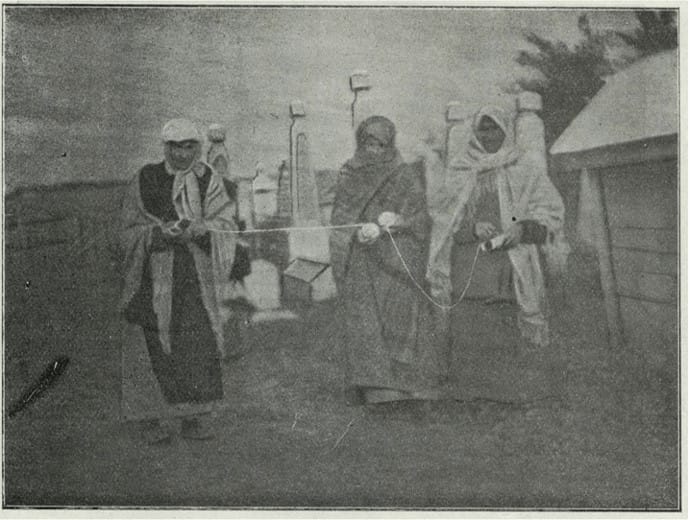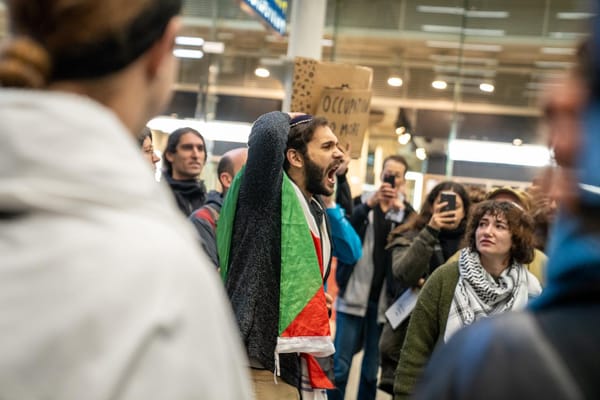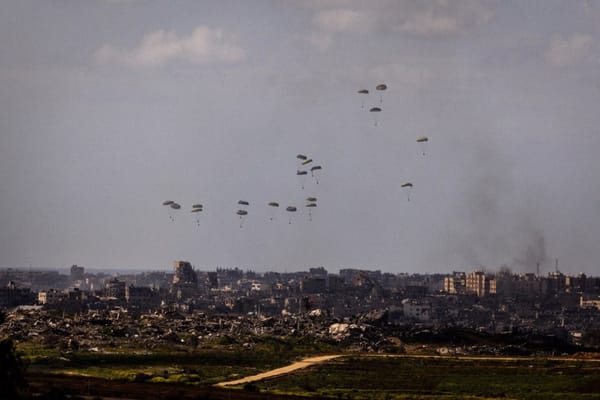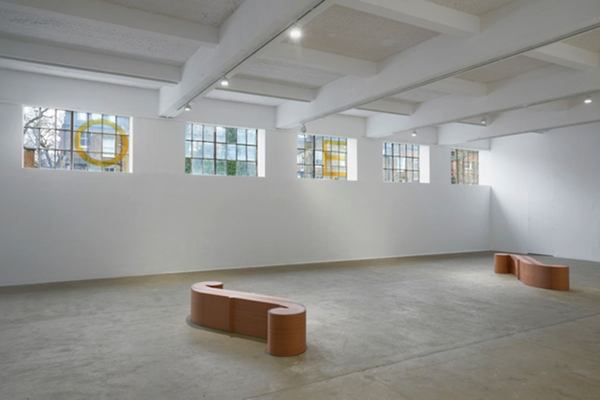The forgotten women's rituals of Yom Kippur
Cemetery- and grave-measuring were part of the female clerical role in Ashkenazi Jewish life, and powerful tools of ancestral connection.

From at least the mid-eighteenth to the early twentieth century, on every Monday and Thursday in the month of Elul, and every day in the period leading up to the High Holy Days, Jewish women in areas of South Russia would take a thread, go to a cemetery or a grave and measure it. After Feldmestn (cemetery-measuring) or Keyvermestn (grave-measuring) came Kneytlekhleygn (wick-laying), in which the measuring threads would be dipped in wax and used for neshome likht (soul candles) on Yom Kippur and other occasions.
The women performing these measurements, which were practised all over Eastern Europe, were experienced elders known as feldmesterins – cemetery-measurers – and were often paid; a number of Yiddish texts list “feldmesterin” under jobs women did to supplement their husband’s income. While sometimes dismissed as purveyors of superstitions and even witchcraft, others sources view feldmesterins as keepers of an important connection between the living and the dead. Either way, cemetery- and grave-measuring exemplify not only forgotten rituals and magics, but a forgotten female clerical role in Ashkenazi Jewish life.
In contrast to some of the derogatory descriptions of feldmesterins, the women who employed them are usually described as pious and upstanding. In a fictionalised account, Yiddish author Mendele Moykher Sforim describes his mother, who made candles for Yom Kippur, as “a learned woman [who] knows all the tkhines [Yiddish prayers] from Erets-Yisroel [the land of Israel] […] and all the laws of the three mitzvot which concern women […].” The particular tkhine she recites whilst making the candles is included in 18th-century liturgist Sore Bas Toyvim’s popular collection, Shloshe Sheorim (The Three Gates). One of the best-known prayer books for Ashekenazi women, it includes the act of making and blessing Yom Kippur candles as an important part of the female mitzvah of hadlakat nerot (kindling Shabbat and festival lights). The candles would be donated to houses of worship and study, lighting up spaces from which women were traditionally excluded.

In the tkhine said by the feldmesterin during Keyvrmestn, the dead are reminded of their connection with the living and asked to pray to God on their behalf. The tkhine for kneytlekh leygn uses this living-dead connection to invoke the ancestral line, and the merits of those ancestors who might best be able to invoke God’s mercy upon the living. It seems that practitioners believed that by drawing the thread around the graves of the more recently departed, they would be imbued with the power of ancestral connection, suggesting that the earth in which they were buried could provide a tangible link in the chain leading back from the living to the matriarchs and patriarchs with whom God made his covenant.
Both Feldmestn and Keyver Mestn exemplify the symbolism of encirclement in Jewish history and tradition. In the book of Joshua, the Israelites encircled the city of Jericho carrying the Ark of the Covenant until the city walls fell at the sound of the shofar. On Simchat Torah, the Torah is carried around the bimah in seven or more hakafot (circular processions). At Jewish weddings, the bride encircles the groom seven times, a sign of devotion but also of protection. In seventeenth-century Germany, women would use a ceremonial knife to cast circles of protection around a woman who had just given birth. From ayin hore (evil eye) to shtreimels (furred hats), wedding bands to bagels, circles serve three primary purposes: they symbolise the cycle of life and death, open portals between one world and the next, and generate protective energy. Cemetery- and grave-measuring serve all three, reinforcing an ancestral connection intended to protect us from God’s wrath.
Both Feldmestn and Keyver Mestn exemplify the encirclement woven into Jewish history and tradition.
Although most commonly associated with Yom Kippur, the rituals were also practised at other times when the veil between the the living and dead seemed to thin. A 1958 memorial book from Pruzhany, Poland, written after the community’s destruction in the Holocaust, recalls how cemetery-measuring was used in times of “severe illness”. Writing in 1792-93, the Lithuanian Jewish philosopher Salomon Maimon describes how his mother-in-law employed a Feldmesterin to help her assuage a malevolent spirit. And in Moyshe Kulbak’s novel Montog (1926), set during the Russian Revolution, two witchy Feldmesterins, Stesye and Gnesye, weave magic with their thread, uncoiling it “longer and longer up in the sky, until it entangles the church spires and tall towers of the city […] catches the stars in its web […] spins, and weaves, and envelopes the whole town in a dead thread.”
As we prepare for Yom Kippur amidst a pandemic, we would do well to remember these forgotten rituals of connection and protection. As a 1916 tkhine written in case of an epidemic says: “zol keyner nit feln in undzer gvul” (let no one be missing from our boundary). A ritual for grief that can be performed with just two or three people might also be useful at a time when we cannot gather in minyans. In rediscovering this ritual, we are also paying homage to one particular role played by generations of women who have been erased and forgotten from the history of religious Judaism.
How to perform Feldmestn
Begin at the entrance of the cemetery. One person holds a large ball of cotton thread in one hand. The other stands to the right of them, gathers some grass or “any other suitable object” from the cemetery floor and holds it in their left hand, taking the end of the thread in their right.
Turn left and move together slowly around the cemetery perimeter in a clockwise direction. As you walk, the first person slowly unrolls the ball of thread, which the second person lets fall on the on the object they hold in their left hand, winding up the thread in their right.
The person who intends to make the candles (usually the person with the connection to that specific cemetery) walks behind those measuring, reciting prayers. While I haven’t found any of these specific prayers, the one below, said during Keyvermestn, could be adapted.
In some places a song was sung during the measurement. This is an example of such a song from Pruzhany, Poland, recorded in the Yizker bukh mentioned above:
כ’האָב אַ מאַמע צײטעלע, פֿאַר איר נשמה אַ קנײטעלע, דרײט מען דאָס פֿעדעמל שטאַרק, לאַנג, לאַנג.
Kh’hob a mame Tseytele. Far ir neshome – a kneytele. Dreyt men dos fedeml shtark, lang, lang.
I have a mama, Tseytele. For her soul – a candle wick. The thread is spun, strong, long, long.
How to perform Keyvermestn
This ritual requires only one person. Wrap the thread clockwise several times around the perimeter of the grave, being sure to wrap the thread around the back of the headstone. If you would like to wrap a specific number of times, I suggest seven, a number that was used in similar kabbalistic rituals.
Say the following prayer before or during the measurement. If not performing the measurement, the living relative for whom the measurement is being performed may want to add their own prayer, or the Mourner’s Kaddish.
טײַערער פֿאָטער (מוטער און ד.ג), דײַנע טאָכטער (נאָמען) האָט זיך מטריח געװען צו קומען צו דיר און דײַן קבֿר צו מעסטן, זײַ־זשע זיך מטריח פֿאַר איר און איר מאַן און אירע קינדער פֿאַר גאָט צו בעטן. דערמוטיקן זיך אין דײַן פֿריערדיקער ליבשאַפֿט און העלף איר.
Tayerer foter (muter un dos glaykh): dayne tokhter (nomen) hot zikh matriekh geven tsu kumen tsu dir un dayn keyver tsu mestn, zay-zhe zikh matriekh far ir un ir man un ire kinder far got tsu betn. dermutikn zikh in dayn frierdiker libshaft un helf ir… (un azoy vayter).
Dearest father (mother/friend/sibling etc – relationship to the deceased): your daughter (friend/sibling etc) (name) has taken the trouble to come to you and to measure your grave, take the trouble to pray to God for her and her husband and her children. Muster in yourself earlier love, and help her… (own prayers can be added here).
How to perform Kneytlekh leygn: (making soul candles)
After the measurement, cut the threads into roughly equal-sized parts, and use them as wick to make candles. Some suggest rubbing the threads in oil or boiling them in saltwater and then leaving them overnight first.
A complete soul candle making kit can be found here, including pre-dipped wicks and adaptations for those without access to a cemetery.
Here is a full source sheet and ritual guide. A shorter version of the guide, along with other resources for this year’s High Holy Days, can be found here. ▼
Annie Cohen is a PhD student in Modern Jewish Studies at the Jewish Theological Seminary in New York, and a Kohenet in training. She spent the past year studying at the Paris Yiddish Center, where she discovered the sources used in this research.




